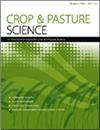茎、叶和子叶对澳大利亚常见菌核菌病型的抗性反应为提高普通豆的抗白霉性提供了新的机会
IF 1.8
4区 农林科学
Q2 AGRICULTURE, MULTIDISCIPLINARY
引用次数: 0
摘要
白霉病(Sclerotinia sclerotiorum)对普通豆(Phaseolus vulgaris)造成重大产量损失;然而,以高产和适应市场的籽粒而闻名的商业品种缺乏对这种疾病的生理抵抗力。目的研究不同基因型大豆在茎、叶和子叶组织中的抗性。方法将34个具有广泛农艺性状和籽粒型的常见大豆基因型(包括先前发现的对白霉病敏感和抗性的基因型)接种于流行的菌核葡萄球菌分离物MBRS-1。然后用105mL−1菌丝片段浓度接种植株,在控制的环境条件下,评估它们在茎、叶和子叶组织中的抗性。主要结果不同基因型水稻茎、叶和子叶组织的抗性反应差异显著(P<0.001)。在茎部抗性最强的是“挑战者”、ICA Bunsi、XAN 280和Taisho-Kintoki,而叶片抗性最强的是“诺维尔2558”、“Pico de Oro”、“Sanilac”、“奥赛罗”和“黑天使”。梅蒂斯、加那里奥107、皮科·德·奥罗、波贡尼翁和朱比尼亚287在子叶上表现出最大的抗性。结论:这是首次报道的测定普通豆种质对澳大利亚一种常见菌核病菌病原型的反应。本研究鉴定的具有高抗白霉病能力的大豆基因型可作为普通大豆育种计划的亲本系,或直接作为改良品种。本研究强调了在受控环境条件下筛选对可靠定位新的茎、叶和/或子叶抗性的价值,以及利用快速子叶筛选来指示茎抗性的可能性,因为子叶中的抗性表达通常与茎中的抗性表达密切相关。本文章由计算机程序翻译,如有差异,请以英文原文为准。
Stem, leaf and cotyledon resistance responses to a prevalent Sclerotinia sclerotiorum pathotype in Australia highlight new opportunities to improve white mould resistance in common bean
Context White mould (Sclerotinia sclerotiorum) inflicts major yield losses on common bean (Phaseolus vulgaris); yet, commercial cultivars known for their high yields and market-adapted grains lack physiological resistance to this disease.Aims This study aimed to test diverse common bean genotypes for resistance in stem, leaf and cotyledon tissues.Methods Thirty-four common bean genotypes with a wide range of agronomic traits and grain types, including genotypes noted previously for susceptible and resistant responses to white mould, were inoculated with the prevalent S. sclerotiorum isolate MBRS-1. Then they were assessed for resistance in stem, leaf and cotyledon tissues under controlled environment conditions, by inoculating plants with a 105mL−1 hyphal fragment concentration.Key results There was significant (P<0.001) variation in resistance responses in stem, leaf and cotyledon tissues across the genotypes. Contender, ICA Bunsi, XAN 280 and Taisho-Kintoki showed the highest resistance in stems, whereas Norvell 2558, Pico de Oro, Sanilac, Othelo and Negro Argel exhibited notable resistance in leaves. Metis, Canario 107, Pico de Oro, Pogonion and Jubilejnaja 287 displayed the most resistance in cotyledons.Conclusions This is the first reported attempt to determine the response of common bean germplasm to a prevalent pathotype of S. sclerotiorum in Australia. Bean genotypes exhibiting high-level resistance to white mould identified in this study can be used as parental lines for crosses in common bean breeding programs and/or directly as improved cultivars.Implications The study highlighted both the value of screening under controlled environmental conditions to reliably locate new stem, leaf and/or cotyledon resistances and the possibility of using rapid cotyledon screening to indicate stem resistances because the expression of resistances in cotyledons generally correlated strongly with those in stems.
求助全文
通过发布文献求助,成功后即可免费获取论文全文。
去求助
来源期刊

Crop & Pasture Science
AGRICULTURE, MULTIDISCIPLINARY-
CiteScore
4.20
自引率
15.80%
发文量
111
审稿时长
3 months
期刊介绍:
Crop and Pasture Science (formerly known as Australian Journal of Agricultural Research) is an international journal publishing outcomes of strategic research in crop and pasture sciences and the sustainability of farming systems. The primary focus is broad-scale cereals, grain legumes, oilseeds and pastures. Articles are encouraged that advance understanding in plant-based agricultural systems through the use of well-defined and original aims designed to test a hypothesis, innovative and rigorous experimental design, and strong interpretation. The journal embraces experimental approaches from molecular level to whole systems, and the research must present novel findings and progress the science of agriculture.
Crop and Pasture Science is read by agricultural scientists and plant biologists, industry, administrators, policy-makers, and others with an interest in the challenges and opportunities facing world agricultural production.
Crop and Pasture Science is published with the endorsement of the Commonwealth Scientific and Industrial Research Organisation (CSIRO) and the Australian Academy of Science.
 求助内容:
求助内容: 应助结果提醒方式:
应助结果提醒方式:


